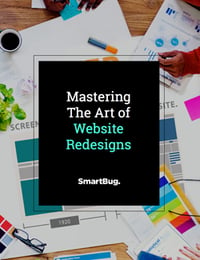
How Much Should Your Website Cost? A Guide to Web Design Pricing
October 18, 2018
By Kyle James
Trying to create a definitive guide on the costs of a website is a large undertaking. I might even be so bold as to say it's as ambitious as trying to put together a guide on how much you should pay for normal daily transportation. You could buy a car ($$$) or even a plane ($$$$$), but you could also buy a moped ($$), bike ($), or rely on cab services. I mean there is also the option to walk.
In approaching this topic, I want to set a few ground rules: I won't get into individual costs of each of the eight items outlined below. Hopefully, by teasing out what is in each, you can get an idea of what each will cost. I’m also narrowing the focus here to marketing websites with a greater focus on B2B sites than B2C. This is important because a food truck (B2C model) could easily get by and succeed with a page on Facebook as their website presence. Finally, I’m not including the obvious parts of building a website, such as coding it (or finding a template), website hosting, and a domain name.
Will all that in mind the following list are items that absolutely should be included in building a website properly. If they aren’t then corners are being cut and you aren’t getting the best possible
Let’s get into the list.
1. Does a Brand Style Guide Exist?
This is step one of a web design project if your company doesn’t have brand identity guidelines. Asking a third party to design a new website without a brand identity is asking them to basically shoot in the dark.
Having locked-down elements, such as colors, fonts, logos, photography, and graphic direction, is critical for helping a designer understand who you are and how you want to be perceived by the market.
2. UX Discovery?
To understand what you want to build, you need to understand what you are doing now and how it is performing. UX discovery includes things like a site audit to identify what currently exists, a review of all analytics, industry and competitor research, and more. Of course, some of this only applies if you have a current website to benchmark.
3. Do You Need to Do Persona Research?
Do you have marketing personas? If you don’t fully understand who your ideal customers are and why they buy, you won’t create things that resonate with them. Learn more about inbound marketing personas.
4. Who Is Writing Copy?
Copy is still king. Writing quality website copy is a special skill and shouldn’t be undervalued. I highly recommend thinking twice before assuming you're the expert at your business and can do this with no problem.
5. How Many Pages?
Page count is a common metric used to price out the costs of a website build, for obvious reasons. All pages aren’t created equal, so when deciding that you want to build a 20- versus a 40-page site, don’t be surprised if it will cost you twice as much.
6. Are Multimedia or Interactive Elements Required?
Things like video, website animations, transition effects, responsive design, and so on take time to build and optimize.
7. Is Content Migration Involved?
There are lots of types of content that you already have that you might want to keep for your new website, but they will need to be migrated over. Are there downloadable resources with landing and thank you pages that need to be migrated or at least have the templates updated to the new design? How about a blog that needs to be updated to a new design or a new platform altogether? Newsroom or press releases? Calendar and Events? Don’t get caught assuming these items are all part of the new plan.
8. What Is the Plan for Ongoing Development and Maintenance?
Hopefully, it’s obvious, but just because you launched a website doesn’t mean you can completely neglect it and not continue to invest in it. Ongoing content creation (blogs, guides, infographics, and gated content), testing and conversion rate optimization, software updates, security patches, and more should be part of your cost considerations.
The first seven items set the stage for success, but because your website is the face of your business 24/7/365, you have to maintain it. Web technology and design expectations are constantly changing and adapting. What a business could get from their web presence 20 or even 10 years ago continues to change. As much as a well-designed and easy-to-use website can help your business, an obsolete and outdated website can hurt you.
Final Thoughts
By this point, you’ve probably picked up that much of this list are items that should happen at the beginning of a website redesign, meaning owning an impactful website has a lot of upfront costs. This discovery is critical for assuring that all future spend is optimized effectively. I could easily write dozens of articles focused on the eighth item in this list, but planning is an important step to take before jumping in and building something new.
What do you think? What steps would you include that I missed? Anything that you would prioritize differently?
One final thought I’ll leave you with is that I firmly believe you get what you pay for. Today, many companies will sell you an affordable new website that can be up in hours or days. That is always an option, but I’m confident it wouldn’t represent your company nearly as well as doing all of the items listed.

About the author
Kyle James started his path to becoming an Inbound Marketing Ninja back as a College Webmaster, yes back when that was a real job title. Kyle was one of the original Inbound Marketing Consultants at HubSpot and has been an advocate of Inbound Marketing ever since. Read more articles by Kyle James.





















